|
Oregonbigfoot.com
Newsletter
January 2005 |
Issue: Jan Year: 2005
Editor: Autumn Williams
© 2005 Oregonbigfoot.com
Sign up! It's Free! |
IN THIS ISSUE |
| >> |
EDITOR'S NOTE |
| >> |
INTERVIEW - Dr. Jeff Meldrum, Associate Professor of Anatomy, Idaho State University |
| >> |
BIGFOOT NEWS |
| >> |
GEAR SPOTLIGHT - IR Booster, Digital Recorder |
| >> |
WEBSITE UPDATES |
| >> |
FEATURED ARTICLE - The Windigo by Michael Nave |
| >> |
IN MY MAILBOX.... |
| >> |
|
For Your Collection: |
|

Meet the Sasquatch
Chris Murphy, with the help of John Green and Thomas Steenburg, as well as many others, may have produced the best Sasquatch/Bigfoot book since Green's "Sasquatch: the Apes Among Us" in 1978.
This book is deceptively thin, but holds within over 640 pictures, some of which have never been published before.

Walking With the Great Apes: Jane Goodall, Dian Fossey, Birute Galdikas
In this study of three great female primatologists, science journalist Montgomery moves beyond biography into ethnology, taking a step that goes well beyond even her subjects' research. Goodall, Fossey and Galdikas each made a similar leap, the author contends, moving from observers and recorders to an almost shamanistic quest to enter the world of the apes they studied.
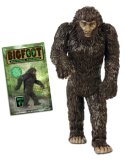
Bigfoot Action Figure
They're big, they're hairy, and they're notoriously elusive! This 7-inch tall, hard plastic Bigfoot Action Figure has stamps on the bottom of its feet and comes with a stamp pad so you can leave mysterious footprints on letters, walls and skin.
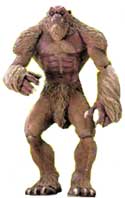
Cryptozoology Action Figure: Bigfoot 
Another one for your collection from Mezco toys.
They're going fast!
Speaking of replicas...
Check this out
An unbelievably LIFELIKE Sasquatch replica from
Nimba Creations!
Eerie, huh?
Money for research?
It's not bigfoot-related, but it's fun. For those of you who are on the computer all the time like I am, this is a great way to make some extra $$$ for being opinionated. <grin> These guys pay $3 for each market research survey you complete. And yes... you can be honest! I guess it's cheaper than hiring locals to come down to the office or paying a telemarketer to call people to ask what they think of this or that ad campaign or product. :)
Check it out
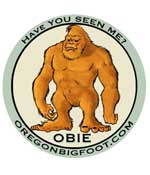
Meet Obie,
Official Mascot of Oregonbigfoot.com!
Thanks to artist Scott Davis once again for his incredible artwork! Add Obie to your bigfoot collection. :) He's available on mugs, mousepads, buttons and more. Also check out the cool new bumper stickers!
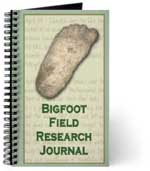
Spiral-bound journal
You asked for it... here it is.
Keep your research notes organized! Take it in the field with you whenever you go...

The Science and Art of Tracking
HIGHLY RECOMMENDED
This book shows how anyone willing to put forth a little effort to go out and practice and get some "dirt time" can learn to follow even the tiniest tracks across the most difficult surfaces. Tom uses a common sense method of tracking that examines a track in terms of "pressure releases." For example: a heavy foot displaces more "dirt" than a lighter foot, a foot traveling fast will displace more "dirt" to the rear of the foot than a foot moving slowly. By measuring the size of these pressure releases one can tell a myriad of things about the creature one is tracking: its size, its direction of travel, its speed of travel and its head position.

Tom Brown's Field Guide to Nature Observation and Tracking (Tom Brown's Field Guides) HIGHLY RECOMMENDED
Hard core tracking tips are blended with instructions on cultivation of the inner silence. Brown gives us practical advice on reading animal tracks, constructing shelters etc. The tips on "Nature Observation" in this field guide are unsurpassed by any other tracking book. TB provides us with priceless descriptions of what happens the moment we enter the forest - that is, how the alarm signal spreads from the birds to mammals and how long it takes for it to subside. The forest he is talking about is a living entity, where everything is connected and where one can plug into the circuits of the information flow by learning to listen to the sounds, by studying the terrain and the wind and by knowing how to camouflage and mask one's smell. The book provides useful info on various types of walking/stalking in the woods.
Do Abominable Snowmen of America Really Exist?
Roger Patterson
There are a couple of copies of this rare book by Roger Patterson (written prior to the famous film)
available right now!
VERY interesting read!
Bigfoot at Bluff Creek
Danny Perez
Bigfoot
B. Ann Slate, Al Berry (HIGHLY RECOMMENDED!)
The evidence for Bigfoot and other man-beasts
Janet Bord
|
|
|
|
| |
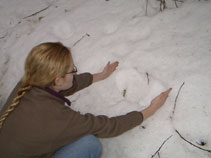
Track in snow near Poopanelly Creek
Clackamas County, Oregon
|
>> Editor's Note:
I always wonder, as I begin a new year, will THIS be the year that indisputable evidence for the existence of Sasquatch is discovered?
Bigfoot research began back in the late 1950's with the Jerry Crew incident in Bluff Creek, which we examined briefly in last month's issue. Researchers like John Green, Rene Dahinden and Peter Byrne, among others, began flocking to the Bluff Creek area... that was a whopping 47 years ago.
Since that time, some compelling evidence has been gathered, though not enough to definitively PROVE Bigfoot's existence. Here's what I believe to be the top three bits of evidence which substantiate the creature's existence:
1. The Patterson/Gimlin film of 1967 (many have tried to debunk it and have failed miserably)
2. Dermal ridge evidence noted originally by Dr. Grover Krantz, further documented Dr. Jeff Meldrum and Jimmy Chilcutt, on many tracks that does not fit any known primate
3. Hair samples gathered from all across the country, sent to Dr. Henner Fahrenbach who, upon close scrutiny, has determined that they come from a primate currently unknown to science
The problem is that very few long-term field studies have been done. Most researchers, due to lack of time and funding, spend only a few days in the field, following up on sighting reports, often getting there after the fact. (As Dr. Meldrum so eloquently states below, research is often "reactive" rather than "proactive".) Most field researchers, save a few, have been men.
This mystery has outlived many of the original researchers, and will likely outlive many more unless a NEW approach is taken.
Historically, women have had enormous success in the field study of primates. Jane Goodall, Dian Fossey and Biruté Galdikas pioneered, respectively, interaction with chimps, mountain gorillas and orangutans. I believe their success is due, in large part, to the fact that all three were female. Before a roar of dissension rises from my male readers, hear me out. <grin>
Our social upbringing creates a vast discrepancy in the way males and females typically react to threatening situations. In general, men are taught to remain in control of a situation. Fear is often expressed as anger and in a threatening situation men are expected to REACT immediately in order to regain the upper hand. Women, on the other hand, are more likely to allow themselves to be vulnerable and expect a different outcome. I call it the "Disney syndrome". As children, Disney movies teach us that the big, scary creature is simply a gentle, misunderstood giant. Women are more likely to hold on to this belief... and to ACT on it.
Reports indicate that Bigfoot creatures are drawn to women and children, perhaps for this very reason.
In Dian Fossey's own words: "I scratched my scalp noisily to make a sound familiar to gorillas…Then I lay back in the foliage to appear as harmless as possible and slowly extended my hand…Finally [Peanuts] came a step closer and, extending his own hand, gently touched his fingers to mine.'" (Mowat 85) This was the first documented intentional physical human/gorilla interaction. Using a combination of assertiveness and submissiveness, Dian earned the creature's trust. What if Jane Goodall and Dian Fossey had left it to the men in their field to make the discovery?
Someone once told me, if you're going to bother to do something, DO IT RIGHT.
Trying to get a "picture" of a Bigfoot is a complete waste of time. There are many purported photos already... and even the Patterson/Gimlin film doesn't constitute "proof". While some advocate attempting to kill a creature and bring in a body, I don't. Not only do I have moral issues with the idea, I think it's impossible to do and dangerously foolhardy to try.
Dian Fossey and Jane Goodall didn't find it necessary to kill their quarry. They merely studied and observed.
Autumn Williams
Oregonbigfoot.com
Your comments are always welcome.
The legend lives.
|
INTERVIEW:
Dr. Jeff Meldrum, Associate Professor of Anatomy, Idaho State University |
| >>Dr. Jeff Meldrum is a well-known figure among Bigfoot researchers, having contributed a vast amount of knowledge and credibility to the field of Cryptozoology. His painstaking examination of Sasquatch track casts and footprint photographs has led to some intriguing discoveries. Thank you, Dr. Meldrum, for lending your expertise to this subject!
Autumn: Please describe your educational background and field(s) of expertise.
Dr. Meldrum: BS, MS Zoology (Anatomy & Physiology emphasis) Brigham Young University, PhD Anatomical Science (physical anthropology emphasis) SUNY Stony Brook, Visiting Assistant Professor Duke University Medical Center, Assistant Professor Northwestern University Medical Center, Associate Professor Idaho State University
Autumn: What particular event sparked your interest in the Bigfoot phenomenon?
Dr. Meldrum: Initially, it was Patterson's appearance in the Spokane Coliseum to show his documentary and film footage, followed by an article in National Wildlife Magazine. I read quite widely on the subject as a youngster ( I learned world geography through Sanderson's tome). Eventually, I became completely out of touch with the subject, until crossing paths with Richard Greenwell. I was invited to examine the "Redwood's video." While this intrigued me, it was the opportunity to examine what appeared to be fresh tracks outside of Walla Walla, Washington that set the hook as far as my intellectual curiosity.
Autumn: What did you set out to discover when you began studying this subject?
Dr. Meldrum: I wanted to conduct a more extensive and systematic assessment of the footprint evidence, since that was an area of research expertise. My aim was to assemble as much of the available footprint cast and photographs as reasonably possibly. I was looking for repeat appearances of recognizable individuals, signs of dynamics, and most importantly indications of the underlying functional morphology of the foot.
Autumn: Please describe your track collection. Where and from whom did the casts come from? Approximately how many are there?
Dr. Meldrum: I have secured the bulk of Freeman's collection from the Blue Mtns of Washington and Oregon. I also have the bulk of Dr. Grover Krantz's collection. In addition, many individuals have been very generous in sharing their discoveries with me and permitting me to duplicate their casts or photographs, for which I am considerably indebted. They have contributed greatly to the picture of the sasquatch foot that has emerged. Each additional specimen has the potential to add another piece to the puzzle.
Autumn: Let's talk for a moment about dermal ridges. What precipitated this discovery? What have you found and why is it significant?
Dr. Meldrum: Krantz is to be credited for first widespread drawing attention to this feature of a limited number of casts of footprints left under specific conditions. I have pointed out additional examples that appear to suggest the presence of dermal ridges. Officer Chilcutt has examined examples of these and has identified typical characteristics of ridge detail that seem to be of a more coarse texture and that exhibit details of flow pattern that are unusual. He also recognized what appear to be healed scars. A great deal of work remains to be done to complete the analysis of this evidence.
Autumn: What other things of interest have you found in your cast collection or in tracks you've studied in the field?
Dr. Meldrum: By examining a large series of footprints, I think I have a better feel for the underlying consistency and the range of variation about the typical pattern. I think we have a better sense of the proportions of the foot and its articulations or joints. The apparent presence of a midtarsal break places the sasquatch locomotor adaptation at the very least parallel to the evolution of bipedalism in Pliocene hominids.
Autumn: As a scientist, what do you feel we really KNOW about this species so far?
Dr. Meldrum: With the emphasis on KNOW, I would have to say very little. I think we can draw reasonable inferences based on consistently reported anatomies and behaviors. It seems a rather generalized and adaptable species that may have a great deal of plasticity in its behavioral ecology.
Autumn: What kind of field research have you conducted?
Dr. Meldrum: I have spent extended time in various regions of the Northwest and Intermountain West in collaboration with several very apt and talented investigators. We have experimented with the application of a variety of devices and instruments familiar to all those who have attempted the same. As funding permits we will continue those efforts as well as explore novel methods.
Autumn: The synopsis for the Rocky Mountain Bigfoot DVD describes hair samples and fingerprint evidence you've examined and found compelling. Can you describe some of this?
Dr. Meldrum: This DVD was produced as a class project by a handful of ambitious and talented ISU students. It focuses on some events, historical and contemporary from this general region. My comments about hair reiterate the conclusions drawn by Henner Fahrenbach, regarding his growing collection of hair samples. As an anatomist, the existence of this distinctive assemblage of hair is quite intriguing, while acknowledging the challenges and difficulties associate with precise hair identification. Similarly the "fingerprint" evidence is in reference to Jimmy Chilcutt's observations, and those who have preceded him.
Autumn: What made you decide to become involved in the "Rocky Mountain Bigfoot" project?
Dr. Meldrum: The course director, Professor Mike Trinklein, is a friend of mine and has been very supportive of my interest and pursuit of this question. I was happy to make myself and my resources available to his students. As I said, I think they did a quite professional job and viewers will find interesting information about this region.
Autumn: What were some of your findings in the field?
Dr. Meldrum: A report of our initial fieldwork in the Siskiyous was published in the journal Cryptozoology, which can be had from the International Society of Cryptozoology (http://www.internationalsocietyofcryptozoology.org/). Other research efforts are ongoing at this time.
Autumn: What about that area suggests that the environment might be suitable for these creatures? Is there evidence of a substantial population?
Dr. Meldrum: There is certainly indication of a dependence on abundant moisture. It is revealing to compare maps with distributions of reports with an annual precipitation overlay. I suspect that population densities overall are less that in the Pacific Northwest, but a consistent presence is indicated and appropriate to the available habitats.
Autumn: Based on your findings and studies of the Pacific Northwest, can you speculate on a population estimate?
Dr. Meldrum: I prefer to approach the subject from the perspective of what seems to be a reasonable population in a given region. If we can speculate on the most likely social structure, It is probably a noyau -- a dominant male with a range overlapping that of several females. They seem to range widely - one estimate based on analysis of data suggests 1000 square miles (this would certainly vary with habitat productivity and season). Take such a unit and extrapolate to the area of suitable habitat and you might have an approximate number.
Autumn: In your opinion, what would constitute "proof" of these creatures' existence? Are dermal ridges, hair samples and footprints enough?
Dr. Meldrum: Traditionally, a type specimen is needed to establish the existence of a novel species. It is my hope that definitive DNA data will suffice in this case, although there is no precedent for that. Without a type, it still remains an inference that the tissue yielding the DNA indeed came from a sasquatch.
Autumn: The Skookum cast - what makes it so compelling? What's your final determination?
Dr. Meldrum: I have actually never suggested that the Skookum cast is all that compelling. It is rather obtuse, in that its significance is lost on all but those who have the specialized knowledge to recognize it for what it appears to be. Had there been a clear sasquatch footprint associated with it, much of the silly speculation would have been avoided. The most striking feature for me was the especially clear heel and calcaneal tendon imprint. I was gratified that Daris Swindler, a fellow primate anatomist, confirmed my identification of this anatomy.
Autumn: What would you suggest as a viable approach to successful field research for an unknown, elusive hominid?
Dr. Meldrum: It must be a proactive, rather than a reactive approach. We need to become familiar with the habitat and its food and shelter potential. Solitary, reclusive animals are notoriously the most difficult to observe and to document. It will require a long-term, sustained and concerted effort in the field.
Autumn: How has your interest in this field been received by your colleagues in the scientific community?
Dr. Meldrum: As you might imagine, the response has spanned the gambit of imaginable reactions, from the enthusiastic support and endorsement to blatant visceral rejection.
Autumn: What, in your opinion, will it take to gather enough interest for a scientific/academic study of these creatures?
Dr. Meldrum: A DNA sequence from an independent lab.
Autumn: Finally, on a personal note, have you thought about how you might react if you were to come face to face with one of these creatures?
Dr. Meldrum: Sitting in a secluded blind at night gives one a great deal of time to reflect on that question. I think I have an informed attitude towards the prospect of that situation should it arise and I hope that I will have the presence of mind to maximize the opportunity. Time will tell.
Related information:
|
BIGFOOT NEWS |
GEAR SPOTLIGHT :
Infrared Booster Light
Digital Voice Recording |
>> Ape Sighting Draws Interest
By Gary White
The Ledger
Lakeland, FL - If the Green Swamp ape actually does exist, its ears must be burning.
Lakeland resident Jennifer Ward went public in November, sharing her description and drawings of a hairy, human-shaped creature she claimed to have seen on the edge of the Green Swamp in August. Ward's tale has reverberated through cyberspace, with links to the original Ledger story and a subsequent Orlando Sentinel article showing up on such sites as Paranormal News, Dr. Mysterian and American Monsters.
>> more...
>> Lost Apes of the Congo
A TIME reporter travels deep into the African jungle in search of a mysterious chimp called the lion killer
STEPHAN FARIS
Monday, Jan. 17, 2005
Ron Pontier was flying light and low above the northern wilds of the Democratic Republic of Congo when he saw a dark shape racing between two patches of tropical forest. "It was huge," says Pontier, a missionary pilot. "It was black. The skin was kind of bouncing up and down on it." From its bulk and color, Pontier thought it was a buffalo until he circled down for another look. "I saw it again just before it went into the forest," he says. "It was an ape--and a big one." Not buffalo size, but big..
>> more...
>>Belize "Bigfoot" expedition a success
Houston, TX---Ken Gerhard, a field investigator for the American Primate Conservation Alliance (APCA) and the Center for Fortean Zoology just returned from a successful research trip to Belize looking for the Sisemite and Dwendi, two cryptid Bigfoot-like primates said to roam the country's dense forests.
"We were really excited to help sponsor Ken's mission with equipment and happy to report that he is back safely and found some strong evidence of cryptid primates in Belize, particularly the Dwendi," said APCA founder Chester Moore.
Gerhard found four nicely formed tracks that fit the profile of the Dwendi, a miniature Bigfoot-type creature similar to the Orang-Pendek of the Pacific.
"I've been talking about an expedition to Belize for awhile and after Ken went down and found this evidence I will certainly be venturing to Belize in 05 to continue the work," Moore said.
"Ken is an excellent field investigator and we're glad to have him as part of the APCA and glad we could have some involvement with the mission. The next step is going back down with more equipment and now thanks to Ken with an idea where some of these animals are and do a major follow-up," Moore said.
To view photos from the expedition, go to http://www.cryptokeeper.com/news.htm
>>Brain Processes Whistled Language Just as Spoken
LONDON (Reuters) - Like Snow White's seven dwarfs, shepherds on one of Spain's Canary Islands whistle while they work and use the sound to communicate over long distances.
No one knows how long the shepherds on the island of La Gomera have used the rare whistled language called the Silbo Gomero, but American and Spanish researchers said on Wednesday that the brain processes it like a spoken language.
>> more...
(Editor's Note: Eyewitnesses and historical accounts alike often describe these creatures vocalizing with a "high-pitched, whistling scream". This is evident in the pursed lips on Native American totem carvings of the Dsonoqua, or Cannibal Woman - reportedly a Sasquatch-type creature. You can hear a sampling of these vocalizations here, recorded in 1978 in Snohomish, WA.)
>>Just for fun!
Bigfoot photo hunt game |
>> How well can YOUR Sony Nightshot™ see in the dark?
While Sony camcorders offer NightShot™, the range of the infrared is usually poor... meaning, unless a creature is standing within ten feet, you won't be able to capture the image on film in the dark.
With an IR booster light, you can monitor the dark much more effectively.
This Infrared Emission light extends Sony's NightShot™ feature by up to 100 feet. The light uses just 3 watts of power, so it won't put a high drain on your camcorder battery. It also lets you adjust the lighting to match the needs of each shot.
It's a must-have for any field researcher.
>> Get crystal clear recordings and 15 hours of record time!
You didn't have the old tape recorder running because you were trying to conserve tape and battery life. You missed the recording of a lifetime (don't feel bad - it's happened to me more than once!).
This little gem holds more than 15 hours of recording time (945 minutes). This Digital Voice Recorder is less than 3 ounces and a 1/2 inch thick, but it has the functionality you need. USB compatibility lets you quickly transfer audio to your PC. The 32MB Built-In Flash Memory makes it possible to re-record over and over without distortion or loss of clarity. It's easy to operate, thanks to the professional style design, which includes One Button Play from Record, Incremental Rewind, and simple playback/editing functions. All that, and it'll fit in your shirt pocket. |
|
WEBSITE UPDATE: |
|
>>28 new reports added in January
>>New Frameable Art Print available from Scott Davis
>>New FREE desktop background - Autumn's first attempt at digital art <grin>
|
FEATURED ARTICLE:
The Windigo - by Michael Nave |
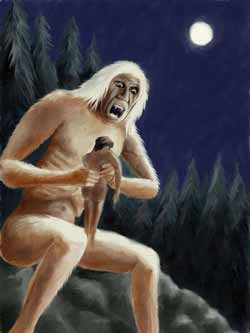 The Windigo
The Windigo |
>> The name Windigo originated from the Algonkian word witiku,
which translates to evil spirit and cannibal. The Windigo, also spelled Wendigo, is considered to be the most fearsome creature of the Algonkian people. The Algonkian tribes include the Micmac, Montagnais-Naskapi, Algonkain, Ojibwa, Cree, and the Blackfoot tribes. The Ojibwa tribe also includes stories of the Windago or Weendego, described as a legendary tribe of giant and ferocious cannibals. According to Algonkian folklore, the Wendigo haunts the forests in an area ranging from the eastern United Sates, to the Rocky Mountains, and as far north as the Arctic Ocean.
To the Algonkians the Windigo is the human who has been transformed into a cannibalistic monster by tasting human flesh in a time of starvation. The Windigo's fearsomeness is attributed to the embodiment of the temptation to consume human flesh in times of famine, making the Windigo the most feared personification of physical and spiritual famine. The Wendigo has the ability to take the form of a half-phantom, half-beast that roams the forest, it is known to feast on flesh and blood, has the ability to shape-shift at will, and is also known for scaring its victims to death with a single glance. Windigos are also known to strike such terror into a person that the victim would be transformed into a cannibalistic zombie. Windigos are rumored to be ten feet tall, made of stone and ice and possess supernatural strength and speed and have the ability to blend into trees. According to Algonkian lore, "to come into the presence of a Windigo will trigger transformation into one and to be bitten by one or to dream of one would also lead to this irreversible transformation."
According to some, the best way of describing the windigo is of a tall, man-like creature, similar to a Sasquatch, or Bigfoot. Although these creatures exist almost entirely in Algonkian folklore, there is reason to believe that they or an extremely close relation to them exists outside of this folklore. There have been sporadic reports of Windigo sightings all over the Algonkian territory, from the coastal shores to the prairies in Alberta, to the North-Eastern United-States with a sighting in Northern Ontario as recent as 2001. Within recent years, tracks consisting of disproportionately large human-like footprints were found in Northern Ontario; many have attributed these tracks to the Windigo.
Although the Windigo is known to have originated in the Algonkian folklore, we cannot help but to wonder what if any relation these creatures have with modern day Sasquatch. While documented Sasquatch reports are apparent throughout recorded history, Algonkian folklore is full of accounts of creatures similar to the Windigo, most of these creatures closely resembling Sasquatch in many ways. These many similarities could make the case that not only does Sasquatch exist in modern times, but it has existed among the Native American tribes for centuries.
Resources:
http://Istina.rin.ru/eng/ufo/text/169.html
http:// www.otherkin.net/harmonyDiscord/ orc/magickal_creatures/windigo1.html
http:// www.bfro.net/legends/penutian2.htm
|
IN MY MAILBOX... |
| >> I receive hundreds of emails each month. Occasionally, a particular message stands out. These readers have agreed to let me share their emails with you. This one is of particular interest in light of the "whistling" article above. Hi Autumn,
I saw that there are audio files of bigfoot calls and screams on oregonbigfoot.com. Are there any vocalizations that resemble a discernible language that you know of? I think it would be interesting to see if there are any telltale signs of language among these creatures, and if so, what sort of linguistic phenomena occur in their language or if they possess language at all. A linguistic analysis might even assist in determining hoaxes from real vocalizations if their language at all resembles human language.
There are several legends in my culture (Kickapoo and Ojibwe) about these creatures, but I have never had any personal experience with these creatures myself. I've heard stories though about Indians meeting up
with one and talking to it while out in the woods. I don't know if they are true or not. Bigfoot, though, is mentioned in certain ceremonies and referred to as bagwaji-inini or "wild man" (in Ojibwe) and so is treated as if he is real. I think it is because of Bigfoot that there is a taboo against whistling at night. I'm not sure though. Just things you hear from time to time. I'll have to ask around about that one. I have heard that we Kickapoos have a whistling language also (or
used to). Something that I need to explore further too as my grandma has not heard about it either.
Wiindigo's are part of the stories that are told with the Ojibwe cultural hero "Wenabozho" (or trickster). These stories are only told in the winter (when there is snow on the ground) though (which it is right now). My understanding is that these creatures are cannabalistic and always hungry and only come out in the winter (and very tall). Parents always tell you not to "overdo" something or go "overboard" with things as the wiindigos will get you". A good lesson in moderation I guess. There is an Ojibwe author, Basil Johnston, who wrote about them in his book, "The Manitous: The spiritual world of the Ojibways". He has some of these stories about wenabozho and the wiindigos and many other stories about the spirits. Just FYI.
At any rate, I am interested in the linguistic aspect as I am a PhD student in Linguistics at the University of Minnesota. My interest is in language revitalization of indigenous languages, but I am also interested in exploring what linguistics may teach us about the communication of these creatures. I am nearly done with my coursework and nearing my dissertation activities.
By the way, I enjoyed your series! Hardly see things on Bigfoot these days.
Sincerely,
Brendan F.
>> A review of "They Call Him Sasquatch" from reader and contributing artist Scott Davis:
I just got my copy of "They call Him Sasquatch" today and watched it this afternoon. I laughed my ass off all the way through it! LOL. It was hilarious and the menagerie of characters chasing down the Sasquatch throughout the film were great, especially my favorites, the two hunters, who really steal the show in my opinion.
The comedy is very well done and so deliberately over-the-top as to not insult a serious Bigfoot researcher and the parodies of some of the more "out there", lunatic fringe researchers are brilliant, from the "Psychic Sasquatch" mom and the British musician who writes all his songs about Bigfoot, to the nerdy sound expert who is so engrossed in his hi-tech recording gadgets that he completely ignores his wife, and the strangely hilarious mountain man, are all very well played by the actors.
This is the type of film where you either "get it" or you don't understand it. If you know nothing about Bigfoot, and the researchers who quest to find him/her, you will probably find this film funny, but if you have knowledge of Sasquatch and the cryptozoology field you should find this film as hilarious as I did. The DVD also includes behind the scenes footage, cast interviews, and deleted blooper scenes that are equally enjoyable. |
FINAL THOUGHTS...
|
>>Think outside the box...
In any field of scientific study, there are pioneers: those who declare that the world is in fact round, while others insist that it is flat. We've talked before about the difference between an idea and a belief. No real scientist should have a motive to prove himself (or herself) right simply because he or she does not want to be WRONG. That's not a search for truth but an Ego Trip.
In science, you TRY different things. It's known as experimentation... If you haven't gotten results with one experiment, you try another. You don't keep rehashing the same experiment over and over, hoping that THIS TIME you'll get the results you were looking for. After a reasonable number of attempts, THE EXPERIMENT SHOULD BE DECLARED A FAILURE and a different approach attempted.
Jane Goodall and Dian Fossey had an advantage - they weren't researching something that was bipedal, intelligently, intentionally elusive with a vast range of movement. They weren't searching for something potentially so close to HUMAN, something that was cognizant and behaved with practiced avoidance.
How many Bigfoot researchers, holding steadfast to the belief that the Sasquatch is "simply a bipedal animal, a human-walking North American gorilla of sorts", UNDERESTIMATE THE NATURE OF THEIR QUARRY? Any hunter knows, if you underestimate a deer's ability to smell you and don't bother to watch the wind, you'll come back empty-handed every time.
Autumn Williams
January, 2005 |
| |